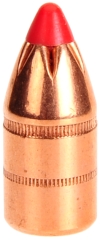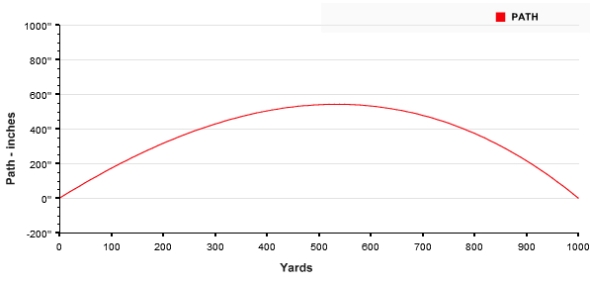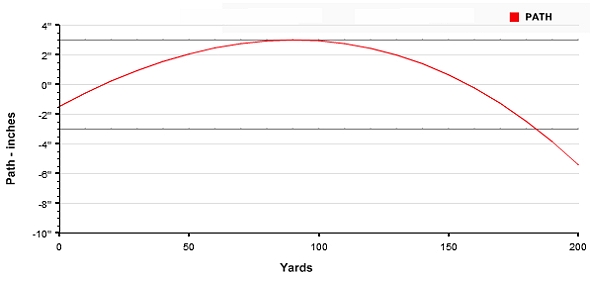
This morning, a collection of bullets was pulled for this project. And hour or two later they were returned to stock and another pull, a different pull, was made. The first selection included machine turned copper and hybrid lead/copper bullets that cost approximately $2.25 to $2.75 per and do not enhance accuracy or control of expansion. So… no designer bullets, just good bullets. Yes, I do realize that five bullets appear above, but six appear in the table below, but thanks for the reminder.
| Bullet Maker | Weight Grains |
Bullet Type |
¢ Per |
Bullet Length “ |
COL “ |
| *Nosler Partition | 300 | JFP | N/A | 0.839 | 2.505 |
| Hornady | 325 | FTX | 64 | 1.100 | 2.590 |
| Hawk Precision *0.035″ | 350 | JFP | 92 | 0.890 | 2.530 |
| Hawk Precision *0.025″ | 400 | JFP | 92 | 0.980 | 2.550 |
| Meister | 405 | LFN | 27 | 1.000 | 2.520 |
| Cast Performance | 460 | WFNGC | 53 | 1.115 | 2.455 |
| *No Longer in Production **Copper Jacket Thickness | |||||
 One of my favorite lighter weight, but very stout bullets, the Nosler Partition, is no longer in production. Since I have a reserve in inventory, but everyone else may not, I thought I would add the Hornady tubular magazine safe Flex Tip. The only reason it was not included in the first place, is the need to shorten brass below specification to assure reliable lever action cycling.
One of my favorite lighter weight, but very stout bullets, the Nosler Partition, is no longer in production. Since I have a reserve in inventory, but everyone else may not, I thought I would add the Hornady tubular magazine safe Flex Tip. The only reason it was not included in the first place, is the need to shorten brass below specification to assure reliable lever action cycling.
The FTX bullet has a long ogive. In order to cycle through a Model 1895 reliably, the case must be trimmed back from a maximum case length of 2.105″ to 2.040″. Even then, the cartridge overall length is set at 2.590″, or 0.040″ longer than the SAAMI 45-70 maximum overall length of 2.550″. The result is a cartridge with solid performance, but brass that is too short for use with any other bullet.
Hawk Precision bullets appear to be costly, but they are not. The pure copper jacket and ability to specify jacket thickness and presence and placement, or non-presence of a cannelure when ordering makes it a semi custom bullet. The copper jacket and soft lead core make for major expansion, but without fragmenting, and good penetration. Beyond the 45-70, Hawk Precision makes bullet for everything from muzzle loaders to the big, Nitro Express cartridges an lots in between.
The Meister bullet has a single lube groove. The company also offers a three lube groove version, shorter than the single groove version, to assure reliable cycling through lever action rifles. The lever action version is specified as 1.035″ in overall length and 0.436″ from crimp groove to nose. The single groove bullets I have on hand measure only 1.000″ in overall length and only 0.420″ from crimp groove to nose and they also cycle reliably. I believe the real benefit of the lever action notated bullet is that its three groove bullet shank has less bore contact and, therefore, reduced bore friction and leading.
The Cast Performance is a tough penetrating bullet. If penetration is the hunting strategy, the Cast performance 460 grain bullet will blow through five feet of ballistic gel. It is a tough, hard cast bullet that doesn’t need a whole lot of velocity to get the job done.

Pictured above, two Buffalo Bore cases use small rifle primers rather than large. Other than the inconvenience of managing two types of brass based on primer size, I have found no difference in performance or found a need to adjust loads. I tend to use magnum large rifle primers and magnum small rifle primers as appropriate, both seem to work well.
Handloads… did not go smoothly

I started out with an RCBS full length sizer and expander, a Redding competition seater and a Lee Factory Crimp die. The RCBS dies would not properly expand and the competition seater would not work with the shorter flat nose bullets and I was too lazy… I mean pressed for time, to make a longer plug. I concluded with a Hornady full length sizer and expander, an RCBS seater and the Lee Factory Crimp die. Vectan, Norma and some of the newer Alliant powders and ended up with the narrow selection below performing best in velocity and accuracy.
None of the loads are particularly compressed, but all are at least near full. The Lee Crimp Dies grabbed onto the Hawk Precision plain shank pure copper jacked bullets as well as they did with cast bullet crimp grooves or the Nosler cannelure. The Marlin was scoped when hundred yard group sizes were recorded, and I believe the Hornady FTX bullets offer enough range to warrant scope use.
 |
Warning: Not for use in Trapdoor design rifles of any date of manufacturer and not for use in vintage firearms. Bullet selections are specific, and loads are not valid with substitutions of different bullets of the same weight. Variations in bullet length will alter net case capacity, pressure and velocity. Primer selection is specific and primer types are not interchangeable. These are maximum loads in my firearms and may easily be excessive in others. All loads should be reduced by 5%, and developed following safe handloading practices as represented in established reloading manuals produced by component manufacturers. Presentation of these loads does not constitute a solicitation for their use, nor a recommendation.
|
||||||||||||||||||||||||||||||||||||||||||||||||||||||||||||||||||||||||||||||||||||||||||||||||||||||||||||||||||||||||||||||||||||||||||||||||||||||||||||||||
|
|||||||||||||||||||||||||||||||||||||||||||||||||||||||||||||||||||||||||||||||||||||||||||||||||||||||||||||||||||||||||||||||||||||||||||||||||||||||||||||||||
An Citizen Kane like introspective, retrospective…
The 45-70 Government cartridge has excellent long range capability in its original, low pressure velocity form. This is the part where I suggest searching the national archives for “The Report of the Secretary of War, 1880, Volume 3” or “.45-70 at Two Miles: The Sandy Hook Tests of 1879” which was publish in Rifle Magazine, November 1977, authored by W. John Farquharson, which detail the .45-70’s precision at ranges of 1,500 and 3,500 yards. What does all of this have to do with the Marlin Model 1895 and current ammunition? Not a whole lot.
The Allin-Springfield Model 1873 Army rifle had a 33″ barrel and bullet weights were 405 and 500 grains. The targets were at known distances and they were stationary. The range had wind cues along the path of the bullets and the shooters were long range shooting marksmen. Additionally, the round nose bullet used on the Trapdoor and other single shot designs were longer in the nose and more streamlined than the stubby bullets used in lever action applications, although at Trapdoor rifle velocity the difference is negligible when determining point blank range or long range trajectory. What does even a 1,000 yard shot with a 45-70 look like at original cartridge velocity?

Definitely two-fur possibilities; a high flying duck at mid range and a standing deer at 1000 yards. Modern velocity and same bullet and range cut the rise about in half. The modern hunter, armed with a rifle like the 18.5″ barrel Marlin Model 1895 gets a 45-70 with a different personality.

With Hornady 325 grain FTX bullet, the Model 1895 has a point blank range of 184 yards and only a 5.4″ drop out to 200 yards, retailing just under 1,400 ft-lbs of kinetic energy.

So what about the Steinstossen version bullet, the +400 grain variety in long range pursuits? As seen above, the 460 grain drops to 153 yard point blank range, they are still 200 yard contenders, but they retain 200 ft-lbs less kinetic energy than the 300 grain FTX. They are, however, bone crushing penetrators that can put down something big and dangerous with certainty. I do not, as yet, have enough ballistic gel to retain one of these when fired from my Model 1895 and I usually stack up a 4′ to 5′ thick wall of the stuff.
The 45-70 cartridge does not pick up a great deal in velocity when barrel lengths are extended to 22″ to 26″ unless the action is very strong, stronger than the Model 1895, and powder charges are also increased. Without this, the difference between the 18.5″ barrel and these long barrels is approx 100 fps max for lighter weights and approximately 60 fps for the heavier range. Going to heavier loads in stronger actions and with longer barrels adds approximately 150 fps on the light end and approximately 100 fps on the heavy bullet end of the spectrum. The result is only 3″ less drop at 200 yards and a pick up of approximately 200 ft-lbs of energy.
So the choice is a 7 lb, 37″ rifle that can drop the largest North American game or a 10 lb 26″ barrel 44″ long single shot that can… drop the largest North American game. A marginal difference in down range performance. Rosebud.
The Return of 1895 Chucky Part I
The Return of 1895 Chucky Part II

Email Notification